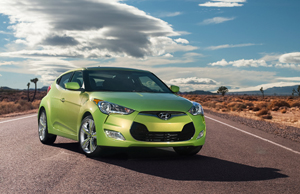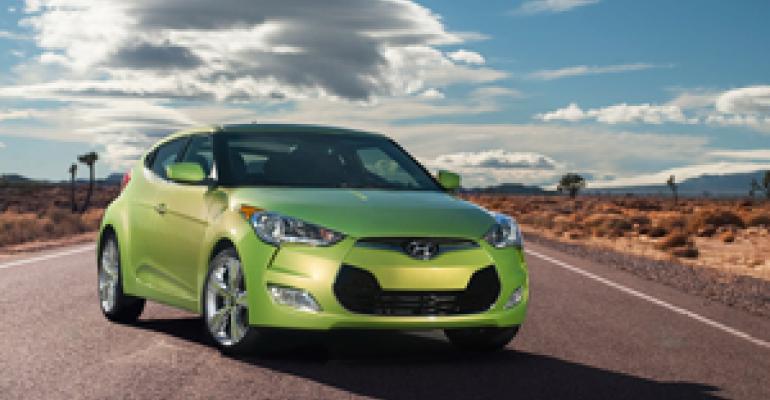
PORTLAND, OR – Finally, an auto maker throws a bone to the hip 20-something men in this country. No one makes cars for them! Just kidding.
Of course, every auto maker is building cars for the young trendy dude in 2011. Hyundai’s current effort to woo this elusive species is the Veloster, now on sale in the U.S., which somewhat serves as a Tiburon replacement.
But unlike that discontinued 2-door model, the newest Hyundai is a 3-door coupe, with a head-turning funky hatchback profile. Some could even call it a 4-door coupe with a liftgate and one extra front-hinged door on the passenger side for easy access to the back seat.
The Veloster is chock-full of all the goodies one expects in a 21st-century car: BlueLink telematics service, Bluetooth wireless phone connection, Pandora Internet radio, light-emitting diodes…the list goes on.
In WardsAuto’s recent drive of a Veloster here, we came away mostly impressed by the car’s many features, Hyundai-typical competition-beating prices and the vehicle’s driving performance.
However, don’t look for the Veloster to smoke your neighbor’s Z in a drag race. As Hyundai freely admits, the Veloster is more about eco-friendly sportiness than going 0-60 (97 km) as quickly as possible. The auto maker pegs the car at a dozy 9.8 seconds.
This shouldn’t be surprising, given it has the same 1.6L direct-injected DOHC 4-cyl. engine, with dual continuously variable valve timing, that appears in both the new Hyundai Accent and Kia Rio subcompacts.
While both of those models offer a lively ride, with 138 hp and 123 lb.-ft. (167 Nm) of torque peaking at 6,300 and 4,850 rpm, respectively, no one could mistake them for rubber-burners.
![<link rel="stylesheet" href="http://subscribers.wardsauto.com/galleries/files/lightbox.css" type="text/css" media="screen" />
<script src="http://subscribers.wardsauto.com/galleries/files/prototype.js" type="text/javascript"></script>
<script src="http://subscribers.wardsauto.com/galleries/files/scriptaculous.js?load=effects" type="text/javascript"></script>
<script src="http://subscribers.wardsauto.com/galleries/files/lightbox.js" type="text/javascript"></script>
<p><a href="http://subscribers.wardsauto.com/galleries/2011/veloster-gallery1.jpg" rel="lightbox[plants]" title="’12 Hyundai Veloster.">View Photo Gallery</a></p>
<a href="http://subscribers.wardsauto.com/galleries/2011/veloster-gallery2.jpg" rel="lightbox[plants]" title=" Veloster IP plastics disguised by design."></a>
<a href="http://subscribers.wardsauto.com/galleries/2011/veloster-gallery3.jpg" rel="lightbox[plants]" title=" Shifter for DCT-equipped models ringed in dust-catching piano-black trim."></a>
<a href="http://subscribers.wardsauto.com/galleries/2011/veloster-gallery4.jpg" rel="lightbox[plants]" title=" Veloster’s rear door is on passenger side only."></a>
<a href="http://subscribers.wardsauto.com/galleries/2011/veloster-gallery5.jpg" rel="lightbox[plants]" title=" Veloster’s wide, low hatchback shape won’t be for everyone."></a>
<a href="http://subscribers.wardsauto.com/galleries/2011/veloster-gallery6.jpg" rel="lightbox[plants]" title=" Seats supportive, optional red leather sharp."></a>](http://subscribers.wardsauto.com/images/2011/10/12-hyundai-veloster.jpg)
Still, hope springs eternal that a car marketed as athletic will move quickly when the gas pedal is mashed, in this case on a moderate uphill grade on the I-5 expressway heading from the Columbia River Gorge to downtown Portland.
But in this case, the torque-lean engine drones in sixth gear with the manual transmission, forcing the driver to find a lower, more appropriate gear. Until the much-rumored turbocharged variant arrives, drag racers need not apply.
The Veloster introduces Hyundai/Kia’s 6-speed dual-clutch automatic transmission, an in-house creation. It uses dry clutches with electro-motor actuators in lieu of wet clutches, which Hyundai engineers deem heavier, as well as less efficient, due to necessary hydraulics.
Gears one, three and five reside on one shaft, while gears two, four and six, as well as reverse, are on the other. Triple-cone synchronizers are on first, second and third gears, while fourth, fifth and sixth gears use single-cone synchronizers.
During a morning drive of a Veloster with the DCT, shifts are fast and take place when expected. Annoying upshifts are kept to a minimum.
However, if a driver wishes to reach sixth gear quickly for optimum fuel efficiency, he can just hit the “Active Eco” button, which modifies engine and transmission control and delivers an estimated 7% gain in mileage.
The Environmental Protection Agency pegs fuel economy at 28/40 (8.4-5.9 L/100 km) city/highway in the manual and 29/38 (8.1-6.2 L/100 km) city/highway in DCT-equipped models.
But WardsAuto returns a respectable 33.5 mpg (7.0 L/100 km) on a 67-mile (108-km) loop with the DCT Veloster. Mileage suffers slightly with the manual, as the vehicle delivers 32.2 mpg (7.3 L/100 km) traveling a shorter, 58-mile (93-km) highway route.
While the DCT, which comes with standard paddle shifters and a manual mode, is the better transmission, the Veloster’s 3-pedal variant is perhaps Hyundai/Kia’s best manual shifter yet, with short throws and crisp movement. The Hyundai coupe’s clutch is surprisingly light for a sporty car.
| Vehicle type | Front-engine, front-wheel-drive 4-passenger, 3-door coupe |
| Engine | 1.6L DOHC 4-cyl., aluminum block/head, gasoline direct injection |
| Power (SAE net) | 138 hp @ 6,300 rpm |
| Torque | 123 lb.-ft. (167 Nm) @ 4,850 rpm |
| Bore x stroke (mm) | 77 x 85.4 |
| Transmission | 6-speed dual clutch |
| Wheelbase | 104.3 ins. (265 cm) |
| Overall length | 166.1 ins. (422 cm) |
| Overall width | 70.5 ins. (179 cm) |
| Overall height | 55.1 ins. (140 cm) |
| Curb weight | 2,657 lbs. (1,205 kg) |
| Base price | $18,550 (MT: $17,300, neither price includes $760 freight) |
| Fuel economy | 28/40 (8.4/5.9 L/100 km) city/highway |
| Competition | Scion tC, Honda CR-Z, Mini Cooper/Clubman, Fiat 500, VW Beetle |
| Pros | Cons |
|---|---|
| Unique looks | Not everyone’s cup of tea |
| Good handling | Sluggish acceleration |
| Lots of tech | Center plastic console |
The Veloster’s standout feature is its ability to hug the road. The car manages to feel light without becoming unstable at higher speeds.
At 2,584-2,657 lbs. (1,172-1,205 kg), Hyundai claims its sport coupe weighs 400 lbs. (181 kg) less than its portliest competitor, the ’12 Scion tC, and even tops the 2-seat ’11 Honda CR-Z.
Hyundai says it is able to achieve this buoyancy through extensive use of high-strength steel, which makes up 65% of the Veloster’s body.
The auto maker also aimed for body-stiffness supremacy, benchmarking the VW Scirocco’s 23.1 Hz of torsional body rigidity. The Veloster achieves 32.8 Hz, Hyundai says.
Although stiff, the Veloster is surprisingly adept at coping with potholes and other imperfections. Hyundai engineers spent much time on the suspension to achieve this level of performance. Mission accomplished.
Much of the car’s stability can be credited to the torsion-axle rear suspension’s V-beam with an integrated stabilizer bar. The integration of the bar allows for improved roll control and a stiffer wheel-hub brace area for better rear-tire alignment, Hyundai says.
The Veloster has a MacPherson independent-strut front suspension, with stabilizer bar and gas-charged hydraulic shock absorbers. Monotube gas-charged shocks are employed in the rear, partly for better heat transfer.
The car’s interior is reasonably spacious, with the backseat fitting an above-average-height female. However, anyone over 6 ft. (1.8 m) tall will have to wedge his head against the headliner.
There are a lot of hard-plastic surfaces on the dash, but the instrument panel doesn’t read cheap, thanks to shapely, curving trim pieces. All the best interior styling attributes of Hyundai’s popular Sonata and Elantra carry over to the Veloster.
The center console is another matter. Here hard plastic abounds, emphasized in big, deep cupholders. In DCT models, shiny, dust-catching piano-black trim rings the shifter.
Optional red leather seats look sharp, as do both black-cloth and leather seats. But the third seat color, a blah rental-car gray, is a head-scratcher for a youth-oriented model.
The car’s BlueLink voice-activated telematics system works well after some initial terminology confusion. Tip: To find the nearest McDonald’s, use “new destination,” not “restaurants.”
The much-talked-about Pandora Internet radio option currently is fully compatible only with Apple’s iPhone. Don’t bother trying to connect an Android-based phone.
The Veloster is a well-appointed, reasonably priced car that is sure to please, but the audience will be limited in size due to its polarizing sheet metal. A squatty hatchback isn’t for everybody. Either way, the shape is boundary-breaking for today’s market, and risk-taking deserves credit in this case.
Now, Hyundai just needs all the young dudes to think so, too.





